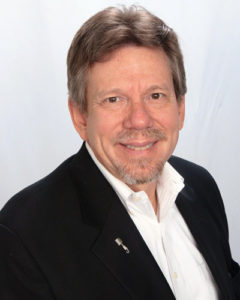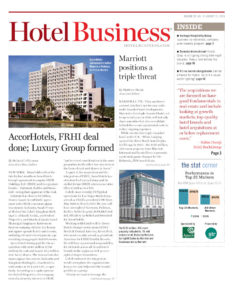With more than 30 years of experience designing meeting spaces for the hotel industry, Jeff Loether knows a thing or two about what’s needed when it comes to turning an empty hotel room into the perfect venue for a meeting or event.
The founder of Electro-Media Design, Ltd., an independent consulting practice, Loether started his career in the 1970s, working in an electronics stereo store. He eventually parlayed his talents for designing recording studios and radio stations into a job with a national hotel brand when Marriott recruited him in 1980.
“I worked inside their architecture and construction division,” he said. “I was a one-person department, responsible for all the new hotel design construction and existing hotel renovations.” He learned about the importance of having a system in place that is consistent, reliable and easy to use. By the time Loether left Marriott in 1990 to start his own busines, he estimates he had opened about 170 new hotels.
At Electro-Media Design, Loether continued to be an advocate for his clients, something he learned during his years at Marriott. “The advocacy role of having our clients’ interests at heart, rather then simply selling equipment is something I learned. At Electro-Media, we don’t sell equipment,” he said. Loether is one of the seven founders of the Independent Consultants in Audiovisual Technology Council (ICAT).
A thorough understanding of the hotel and event business is key to Loether’s success. “One of the ways I try to describe it when I work with architecture firms, design teams, owners, asset managers and brands is to say we are not actually putting on the meeting, we are accommodating the meeting. It’s kind of like theater design,” he explained. “In order for us to understand how to design that venue and what kind of system is needed, we had to understand the meetings industry itself.”
From the very beginning, Loether immersed himself in the industry. He learned all he could by working closely with meeting planers and audiovisual (AV) production companies, discovering what was necessary to accommodate events. “Whether it was a social or business event; whether it was large or small,” he said. “How do we design a venue that will accommodate a whole spectrum of events? It has to be a flexible-type system and also with the understanding that we have to accommodate whoever walks in the door.”
Dave Lutz, VP, asset management, Rockbridge, agrees that flexibility is key when it comes to providing hotel guests with a meeting space that meets their specific needs. “Flexible space is so important,” he said. “We have to be flexible for different types of meetings, for a guest who wants a large ballroom to one who needs it to be divided into smaller spaces and breakout rooms. Most of our hotels deal with business events during the week, but on the weekend, we have social events.”
Jane Brophy, VP, full service operations & shared services, JHM Hotels, agrees that flexibility is essential. She also stressed the important role technology plays, as well as providing unique and local touches. “There’s the social side, the guest who is looking for a unique backdrop,” she said. “And then you have the business client who is looking for technology, productive workspace and flexibility. Everyone is looking for a local and unique experience.”
Loether shares his knowledge with others as an instructor at industry events and has had many meeting planners come to his technology sessions to learn about the various AV options available. He, in turn, has learned from them. “That’s sort of the dance that Electro-Media has been doing and I believe it’s what makes us unique form other consultants,” he said.
Although Electro-Media has clients in other industries, Loether recognizes the hotel industry has some unique needs. Other venues such as educational facilities and corporate venues are closed systems, he explains. “They have complete control over their networks, over who will use that room, ” he said. “A hotel meeting room has to be able to cover a very wide range of users, facilitators and meeting planners. Some may bring in their own technology or their own AV production from the outside. The hotel and conference center environments are public venues to serve the guests and that’s why the reliability, the ruggedness, the flexibility and the room itself are a lot more important. Corporate venues are more purpose built; hotels are more show business.”
When asked if the rapid advancement of technology has made his job easier or more challenging, Loether said, “There have been shifts over the last 15 years or so. From discreet analog components to integrated digital components. The thinking through and the design of complex sound systems have gotten easier. What ha’s been challenging is the more we look at advancing event technologies such as videoconferencing, telepresence, robotics, streaming and hybrid meetings; the more cameras, recording and microphone elements that are introduced, the more important are acoustics, lighting and isolation of spaces from each other,” he said. “In the early 1990s, we coined the term ArchiTechnology, to describe the study of how technology, interior design and human beings work together.”
Loether cites the Marriott Renaissance Hotel in Dallas as an example of where they were given the lead over interior design. He and his team were allowed to define the infrastructure first and then interior designers took over. He also mentioned how, in the past, architects and interior designers never wanted to see the technology. “Now, we’re hearing, ‘How can we feature technology? Can we put in digital art on that display?’” Loether said.
A big challenge for hoteliers is updating outdated venues, he adds. “We’re finding that today’s technology shifts, from analog to digital; from standard def to high def, are causing challenges for existing venues that have outdated infrastructure,” he said. “Asset managers and owners hear they have to spend x number of dollars to make renovations no one will ever see. But it’s an investment that will obviously pay off over the next 20 years.”
When planning and designing event spaces, Loether suggests it’s important to “think inside the box,” adding, “Think about how important it is to have a good room. You can’t fix a noisy room or a dimly lit room. You can’t fix it by bringing in portable equipment or with technology. We have to design good rooms so the technology works well.” For more information on creating event spaces, Loether, who is a board member of Hotel Technology Next Generation (HTNG), recommends the HTNG “New Builds Infrastructure Design Guide.” “It’s full of tips and guidelines and best practices. It addresses security, access and that perennial challenge, high-speed internet.” HB



